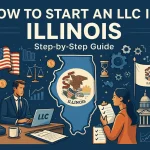Forming an LLC involves several key steps, and it’s important to tackle them in order to set your business up right. Use this LLC formation checklist to make sure you cover each essential task from start to finish. By following these 7 steps, you can avoid common pitfalls and launch your new company smoothly.
Whether you decide to handle the filings yourself or use a professional service, checking off each item on this list will give you confidence that nothing is overlooked in your LLC formation.
1. Choose and Secure Your Business Name
The first step is to pick a unique name for your LLC. Your business name should comply with your state’s rules – generally, it must be distinguishable from other business names on record and include an “LLC” or “Limited Liability Company” identifier. Brainstorm a name that fits your brand and then perform a name search on your state’s business registry to ensure it’s not already taken. It’s also wise to check if the matching domain name is available for your website and to do a quick trademark search to avoid any conflicts. If you’re not ready to file your LLC immediately, most states allow you to reserve the name for a short period of time (for a small fee) so no one else can claim it while you prepare the rest of your paperwork.
2. Appoint a Registered Agent
Every LLC needs a registered agent – a person or company officially designated to receive legal notices and state correspondence on behalf of the business. You can serve as your own registered agent, but you’ll need a physical address in the state and availability during business hours to receive documents. Many business owners prefer to use a professional registered agent service. These services will provide an address for you in the state and handle important documents (like lawsuits or state letters) promptly, notifying you right away. Choosing a reliable registered agent is important because if you miss a legal notice, your LLC could fall out of good standing or you might lose a lawsuit by default.
3. File Your Articles of Organization
Filing the Articles of Organization (sometimes called a Certificate of Organization or Formation) is the action that officially creates your LLC with the state. You’ll need to fill out a form with basic information about your business, such as the LLC’s name, its principal address, the registered agent’s name and address, and possibly the names of the LLC owners (members). This document is submitted to the state agency that handles business filings (often the Secretary of State). Along with the form, you must pay a state filing fee, which ranges from around $50 to $300+ depending on the state. Many states provide online filing for faster approval, while others may require mailing in documents. Double-check that all information is correct before submitting to avoid rejections or delays. Once approved, the state will issue you a Certificate of Organization (or similar confirmation), and your LLC is officially formed.
4. Draft an Operating Agreement
An LLC Operating Agreement is a document that outlines how your LLC will be run. Even though most states don’t require you to submit an operating agreement to form the LLC, it’s highly recommended to create one, especially if you have multiple members. In this agreement, you’ll spell out each member’s ownership percentage, rights, and responsibilities, how profits and losses are divided, how decisions are made, and what happens if a member leaves or if the business dissolves. Having these rules written down will help prevent misunderstandings among owners later. Even single-member LLCs benefit from an operating agreement because it reinforces your LLC’s separate legal status (which helps protect your personal assets). You can write this document yourself using templates, or have an attorney or LLC service help draft one. Once completed, keep this agreement with your business records.
5. Get an EIN (Employer Identification Number)
Next, obtain an Employer Identification Number (EIN) from the IRS. An EIN is like a social security number for your business; it’s a unique federal tax ID that the IRS uses to identify your company. You’ll need an EIN to open a business bank account, hire employees, and file certain taxes. Getting an EIN is quick and free on the IRS website. Simply fill out the online application (Form SS-4) and you can receive your EIN immediately upon completion. Make sure to save the confirmation letter you receive, as you’ll use your EIN on many official documents. If you used an online LLC formation service, they often offer to get an EIN for you as part of their packages or for an extra fee, which can save you one step.
6. Open a Business Bank Account
With your official LLC documents and EIN in hand, head to a bank to open a business checking account for your LLC. Keeping your business’s finances separate from your personal finances is critical for maintaining liability protection and makes accounting much easier. Most banks will ask for your filed Articles of Organization, your EIN confirmation, and possibly your operating agreement when opening an account. Compare small business accounts at different banks to find one with low fees and useful features (some even offer special perks for new LLCs). While you’re at it, consider setting up a business credit card for the LLC to handle business purchases and build credit under the company’s name. Separating finances by using dedicated business accounts will help you accurately track your income and expenses and show that your LLC is a distinct entity.
7. Handle Any Additional Requirements
After the main formation steps, make sure to take care of any extra requirements to fully set up your LLC. Depending on your location and industry, you may need to apply for state or local business licenses or permits before you can legally operate (for example, a local business license, seller’s permit for sales tax, or professional licenses for certain trades). Check your city, county, and state regulations to ensure you’re compliant. Some states also have unique post-formation steps; for instance, a few require new LLCs to publish a notice of formation in a local newspaper. Additionally, be aware of ongoing compliance such as annual report filings or franchise tax payments that some states mandate each year. Mark your calendar with any important due dates to keep your LLC in good standing. By completing these final checklist items, you’ll avoid penalties and be ready to run your business with peace of mind.
Conclusion:
By following this LLC formation checklist, you cover all the bases required to start your new business the right way. From picking a name to securing the necessary paperwork, each step is important to ensure your LLC is legally compliant and built on a solid foundation. Setting up an LLC might seem complicated, but when broken down into a step-by-step process, it becomes very manageable.
If any of the steps feel overwhelming, remember that help is available. You can consult an attorney or use an affordable LLC formation service to handle the filings on your behalf. These services can streamline the process by taking care of the paperwork, and many will also cover tasks like providing a registered agent or drafting an operating agreement. This can save you time and help you avoid mistakes.














